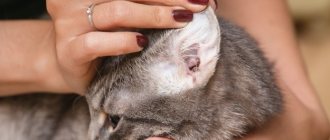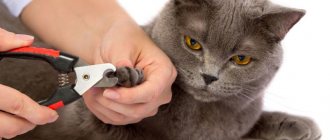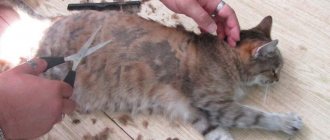By bringing a small fluffy kitten into our home, we take responsibility for its health. In addition to proper feeding, vaccinations, and grooming, ear cleaning should become a regular procedure. This is necessary in order to prevent ear diseases, which cause suffering in pets and take a long time to treat. Questions about how to clean a kitten’s ears, whether it is necessary to do this if the ear is clean, arise often. It all depends on the pet’s lifestyle, the breed, and even the size of the ears.
Structure of a cat's ear
A cat's ears resemble human ears in structure and include:
- external, consisting of a funnel-shaped shell covered with wool with guard hairs inside and the auditory canal;
- in the middle there is an eardrum and a bone cavity with three bones, important in the perception of noise;
- internal - the most complex section, in which the vestibular apparatus and sound receptors are located.
In animals, the auditory canal, unlike the short human one, is curved and forms an angle. Improper cleaning can lead to wax buildup and blockage of the passage.
Cats can hear sound vibrations in the range of 20–100,000 Hz. Muscles and cartilage are able to rotate the shell to pinpoint the source of sound vibrations during hunting.
Drawing - diagram of the structure of a cat's ear
Why do animals scratch their ears?
Scratching your pet's ears is a common hygiene procedure to remove dirt and particles. It is normal to itch several times a day.
What should alert the owner:
- When an animal constantly itches, shakes (shakes) its head vigorously, trying to free itself from an invisible object, and presses its ear with its paw.
- Anxiety, aggressiveness, irritability of the pet.
- Growling, hissing, meowing, and other sounds when scratching.
- Sores, sores, scratches behind the ears (near) and inside.
Such actions can be caused by domestic or pathological reasons.
Household problems are determined by the owner, go away on their own and do not require the intervention of a doctor. These are, in particular:
- water that got in while swimming;
- foreign object;
- minor hematoma from injury;
- scratches the neck - most likely fleas;
- accumulation of earwax due to insufficient care.
There may be cases when the pet lies down. So before you sound the alarm and take your cat to the vet, it’s better to make sure that there really is a problem.
Pathological causes are dangerous to health. The animal needs medical attention if the cause of scratching is:
- abscess;
- allergic reactions;
- fleas;
- fungal infections;
- benign or malignant neoplasms;
- otitis media of various origins;
- ear mites;
- eczema or dermatitis, going bald;
- swollen ear.
What diseases do ticks cause?
Ear scabies, also known as carnivore otodectosis, is a parasitic disease in which a mite lives in or on the pinna of the ear and infects the eardrum or ear canal. The blood-sucking insect causes itching, causing the cat to shake its head and meow. The ear may become scabby and fester. Without intervention, the disease causes complications: otitis, meningitis - or lead to the death of the animal.
Notoedrosis is caused by the sarcopid mite Notoedres cati. The ears, nose, and area under the eyes are affected. The tick affects the nervous, cardiovascular, and reticuloendothelial systems. First, the disease spreads to the muzzle and head, and then moves on to the rest of the body. The animal feels severe itching, scratches its ears, the skin dries out and becomes rough, and bleeding cracks and crusts form.
Otitis is an inflammation of the middle ear. The cat scratches its ears until wounds appear and shakes its head. At the same time, serous fluid with pus is released. This disease is caused by (where does it come from):
- ticks - as a complication of otodecosis;
- bacteria - with a weakened immune system or allergies, the yeast fungus Malassezia develops in the ears;
- both reasons at once - in this case mixed type otitis occurs.
Signs of ear plug formation
Sulfur plugs often form completely unnoticeably. When pain or uncharacteristic sound effects appear, many suspect otitis media, although such pathological symptoms often indicate the formation of sulfur accumulation.
Most often, sulfur plugs make themselves felt after swimming. The development of pathological processes can be suspected by the following symptoms:
- pain, itching;
- unusual noise, crackling;
- feeling of fullness;
- you can hear your own echo in your head;
- discomfort when chewing food;
- distortion of sounds or hearing loss.
Situations where cerumen plug has formed next to the eardrum are the most dangerous. The patient may experience weakness, cough, dizziness and nausea, but there are no typical symptoms of colds.
It is necessary to visit an otolaryngologist as soon as possible. You should not use folk remedies or try to solve the problem yourself. Inadequate treatment can negatively affect your health. It is important to carry out therapy correctly and in a timely manner.
Medical offers to make an appointment with an otolaryngologist (ENT) of the highest category. A full range of diagnostics and treatment of ENT diseases in Tula. Tel. for recording.
How to determine when it’s time to clean your ears, what happens if you don’t?
Hygiene is one of the main components of caring for a pet. It is better to examine your pet every day: when playing or petting, you can carefully bend the ear and then look. The pet's health is fine if the sink is light pink, clean or with a small amount of sulfur, not dirty (no blackness).
Excess wax accumulates in the ear canal, attracting bacteria and parasites. The sulfur plug leads to irritation of the mucous membrane and begins to put pressure on the eardrum. This spoils hearing and disrupts vestibular functions: leads to impaired coordination of movements, nausea, and vomiting.
Accumulations of dirt can clog the glands, and the contents of the ears can be absorbed into the blood, leading to allergic otitis media. Without treatment, the inflammation spreads deeper and can lead to the death of the animal. With tick-borne otitis media, the parasite eats dead skin cells and causes itching. Scratched areas appear around the cat's ears, and dark spots of pus and sulfur appear inside.
If your pet shakes its head, itches or worries, and black plaque, redness, discharge or spots appear in the ears, this is a reason to contact a veterinarian at the veterinary clinic.
Photo - this is what an ear mite looks like
When to clean your ears
Cleaning is divided into preventive and therapeutic.
For preventive purposes, cleaning is carried out every 2–4 weeks, depending on the breed, as well as the body of a particular animal. The large ears of Maine Coon, Savannah, Cornish Rex, Abyssinian, Oriental, Somali, Siamese cats, Devon Rex, elves, and Sphynx cats get dirty faster.
Sulfur is especially actively secreted in breeds without hair inside the hearing organ, since the hairs protect against pollution.
It is difficult to clean the ears of the Scottish Fold on your own, so it is recommended to clean them once every two weeks. A small amount of secretion protects your pet from disease, so there is no need to clean it more often.
Therapeutic cleaning of a Scottish or British cat is carried out before treatment against ticks, the use of antibiotics or antifungal drugs. Before each use of drops or rinses, the sink should be cleaned with saline solution or lotion. Parasites and bacteria produce their own byproducts that interfere with the action of medications. Cleaning is prescribed by a veterinarian and is carried out until complete recovery.
Healthy clean ears of a British cat
What is it for?
Your pet's ears constantly produce sulfur, a substance that protects the canals from dirt, parasites and other bacteria. However, there is often an excess of it, which the cat is not able to get rid of on its own. In this case, she needs help from the owner. If you leave things to chance, then later you can “get” a pet with wax plugs, otitis media or even mites.
Chlorhexidine and furatsilin solution for care and rinsing of eyes for cats
Symptoms of diseases
It is worth paying attention to the health of your pet if:
- redness of the skin;
- increased temperature in certain parts of the body;
- narrowing of the auditory canal;
- tumors;
- change in the color of sulfur;
- unpleasant strong odors;
- squelching sound when pressing;
- excessive sulfur secretion;
- accumulations of pus and fluid;
- various secretions with blood;
- decreased ability to perceive sounds;
- changes in behavior: the cat shakes its head or tilts it to one side, pulls its ear away or runs away when touched, often itches;
- black sulfur, streaks with impurities are a sign of a mite.
Black inclusions in sulfur are often ordinary dirt. If, after cleansing, minor inflammations remain on the skin, you should seek help from a specialist.
Colorless or milky discharge indicates a lack of microelements or vitamins.
Dry ears and waxy scales indicate dermatitis, as well as a lack of fat in the diet.
Allergies are indicated by colorless discharge from the nose, eyes, and ears.
The ears smell like fish if there is a staphylococcus infection, and rotten meat when there is suppuration.
Only a veterinarian can indicate the true cause of ill health and prescribe the correct treatment, so any of these symptoms require consultation.
Photo of bacterial otitis media
Tumor of the seruminous glands
Preparing for cleaning: what to buy
To care for pets, only specialized preparations are used, especially when cleaning the ears. The products protect against fungus and bacteria, prevent infection, and are safe for pets. The instructions for the product should indicate cleaning, not instillation. Under no circumstances should you take anti-inflammatory drugs if there is no indication for it. For cleaning it is recommended to use:
- AUROCLEAN with chamomile extract softens sulfur;
- Leopard, Dewdrop for cleansing ears;
- EAR cleaner cleans;
- Euracon Pharma Otoklin removes dead skin cells, softens sulfur, moisturizes;
- Doctor Vic softens sulfur, used before using medications;
- Veda acts as an antiseptic, heals, removes inflammation;
- Vetoquinol Otifri eliminates impurities, relieves itching, and improves the condition of microflora.
Instead of lotion, you can use saline solution, boiled water, or chamomile decoction.
What is not allowed during processing is prohibited
The ears of adults and kittens are sensitive and need careful attention. Doctors do not recommend when cleaning:
- use soap, iodine, vinegar, alcohol lotions, hydrogen peroxide. These drugs can cause irritation and dryness;
- use cotton swabs, wrap cotton wool around matches. This can damage the eardrum or push debris into the ear canal instead of out.
Lumps or discharge in the ears are a signal to consult with veterinarians at veterinary clinics.
Errors
Inexperienced owners can make a number of mistakes. Cats themselves do not like encroachments into their comfort zone, and if this is done rudely, it can provoke panic in the pet. Animals have associative thinking and one unsuccessful attempt is enough for the procedure to forever turn into a terrible event.
Is it possible and how to rinse a cat’s nose with saline solution?
Careless use of cotton swabs can damage your pet's hearing system. In this case, it is necessary to show the cat to the veterinarian as soon as possible.
Cleaning the ears of adult cats
Before the procedure, your pet should be calmed down. Screenings will not cause concern if done from a young age. To prevent the animal from harming itself and its owner when cleaning, the cat can be restrained by wrapping it in a soft towel, leaving its head outside.
Cleaning (washing) the ears of animals is not painful, but it is unpleasant. Wiping the inside of the ears of cats and dogs is not enough. Contaminants should be removed from the ear canal without damaging the organ. How to clean it properly:
- Place your pet on your lap or other comfortable surface.
- Apply the cleansing agent until the canal is filled.
- Press the edge of your ear to the ear canal and massage in a circular motion. The liquid inside should be audible.
- Make the cat shake its head. This will remove contaminants out.
- Wrap your finger in a paper towel (can be replaced with a napkin or gauze), remove any remaining dirt. There is still dirt left, repeat steps 2-4, move to the other ear.
- At the end of the procedure, give your pet a treat.
If there is too much contamination, a home procedure may not be enough. If an unpleasant odor appears, contact a specialist who will use professional cleaning products and also prescribe the necessary treatment, if necessary.
How to clean and rinse cat ears: tools and liquids
The cat's ears are cleaned of accumulated dirt and earwax using a swab, disk or cotton swabs . A soft cleaning surface is moistened with mineral oil and Vaseline.
These products help remove dried lumps without pain. Instead of Vaseline, you can use a little baby cream, a drop of peach or almond oil (purified, cosmetic).
Please note: liquid or fat should not drip from the cotton wool - there is no need for excessive wetting.
Rinse the ear with distilled water and saline solution in cases where it is necessary to clean the ear of blood and foreign substances. At home, they use an Esmarch mug, a large 20 ml syringe without a needle, and large bottles with a spout. The stream of water should not enter the ear canal, so the animal’s head is tilted slightly.
It is not recommended to use a match with a piece of cotton wool wound:
- Stiff - any wrong movement can cause pain.
- Short – it’s inconvenient to work.
After cleaning with a greasy product, wipe the ears with a dry cotton swab, absorbing any remaining cleaning product. If radical measures were taken—deep rinsing—the final step is to carefully blot the surface with a water-absorbing napkin or soft towel.
How to clean a kitten's ears
Kittens' ears require inspection and cleaning no less than those of adults. At the same time, the kitten behaves unpredictably and experiences stress.
How to care? The baby must be restrained before the procedure to avoid injury (usually, the kitten is not allowed to have its ears cleaned). An active kitten can be swaddled so that only the head is exposed. Do not tighten your pet's paws to avoid further scaring. After the procedure, give the kitten a treat to compensate for the stress caused. If you clean your kitten regularly, it will get used to it and become calmer. To clean, you will need cotton pads and cleansing lotion or boiled water.
- Gently open the ear with your thumb and forefinger.
- Wet the disc with cleaning fluid.
- Wipe the ear from the inside to the exit.
Training
It should be remembered that cats are not very favorable towards this procedure.
More wayward pets may experience outbursts of aggression and endless attempts to escape from their hands. Therefore, the owner must first accustom the kitten to ear treatment so that it is not associated with danger.
To prevent your pet from experiencing stress every time, you need to play with him before treatment. After the procedure, the cat is rewarded with a treat. In this way, the owner reinforces the positive aspects before and after ear cleaning. This means that the ward will have no reason to panic in the future.











